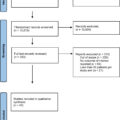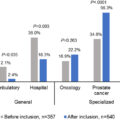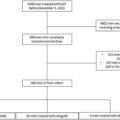Highlights
- •
No population-based study validated the survival benefit of neoadjuvant chemotherapy recorded in clinical trials in a stage-specific fashion.
- •
The current study represents the only retrospective analysis that addressed CSM in NAC versus RC alone according to organ confined (OC) versus nonorgan confined (NOC) stages.
- •
We observed that NAC administration rate increase over time was more pronounced in OC patients than their NOC counterparts.
- •
CSM was lower in NAC-exposed patients in both OC and NOC stages.
- •
However, the magnitude of the protective NAC effect was greater in NOC (HR: 0.66) than OC patients (HR: 0.74).
Abstract
Introduction
Neoadjuvant chemotherapy (NAC) before radical cystectomy (RC) is guideline-recommended in patients with cT2-T4N0M0 urothelial carcinoma of urinary bladder (UCUB). However, no population-based study validated the survival benefit of NAC recorded in clinical trials in a stage-specific fashion. We addressed this knowledge gap.
Methods
Within the Surveillance, Epidemiology, and End Results database (2007–2020), we identified patients with cT2-T4N0M0 UCUB treated with NAC before RC versus RC alone. Cumulative incidence plots and multivariable competing risks regression (CRR) models were fitted. Survival analyses were performed according to organ confined (OC: cT2N0M0) versus nonorgan confined stages (NOC: cT3-T4N0M0).
Results
Of 3,743 assessable patients, 1,020 (27%) underwent NAC versus 2,723 (73%) RC alone. NAC rates increased over time in OC stage (EAPC = 11.9%, P < 0.001) and NOC stage (EAPC = 8.6%, P < 0.001). In OC stage, cumulative incidence plots derived 5-year CSM was 15.6% in NAC and 19.9% in RC alone patients ( P = 0.008). In multivariable CRR models, NAC independently predicted lower CSM (hazard ratio (HR): 0.74, P = 0.01). Similarly, in NOC stage, cumulative incidence plots derived 5-year CSM was 36.1% in NAC and 46.0% in RC alone patients ( P = 0.01). In multivariable CRR models, NAC independently predicted lower CSM (HR: 0.66, P < 0.001).
Conclusion
NAC is associated with improved CSM compared to RC alone, both in OC and NOC stages. Specifically, the magnitude of the protective NAC effect was greater in NOC than OC patients. Thus, NAC should always be administered in all eligible patients before RC.
1
Introduction
Radical cystectomy (RC) with pelvic lymph-node dissection is considered the gold standard treatment for patients with muscle-invasive urothelial carcinoma of urinary bladder (UCUB) [ ]. Current guidelines recommend neoadjuvant chemotherapy (NAC) to all eligible patients with cT2-T4N0M0 UCUB that are candidates for RC, based on 8%–10% improvement of overall survival at five years of follow-up [ , ] However, only 2 large-scale studies addressed cancer-specific mortality (CSM) differences after perioperative chemotherapy, but chemotherapy only emerged a statistically significant predictor of lower CSM in nonorgan confined stages (NOC, namely cT3-T4N0M0) [ , ]. In consequence, the role of NAC in organ confined stage (OC, namely cT2N0M0) requires a formal validation. Additionally, the role NAC in NOC patients may also benefit of corroboration [ ]. Conversely, other studies demonstrated lower overall mortality after NAC administration [ , ] However, due to their design, CSM could not be addressed. Additionally, none of these studies demonstrated better cancer-control outcomes after NAC administration according to OC and NOC stages. We addressed these knowledge gaps and hypothesized that patients who were exposed to NAC before RC will exhibit lower CSM in both OC and NOC stages relative to NAC nonexposed counterparts. We tested this hypothesis relying on the Surveillance, Epidemiology, and End Results (SEER) database (2007–2020).
2
Materials and methods
2.1
Study population
Within the SEER database from 2007 to 2020, we selected patients aged between 18 and 74 with cT2-T4N0M0 and histologically confirmed high-grade UCUB (International Classification of Disease for Oncology [ICD-O-3] site code 8120/3, 8122/3, 8130/3, 8050/3). All patients underwent RC, alone or in combination with NAC. Death was defined according to the SEER mortality code as CSM (death attributable to bladder cancer) or OCM (death attributable to any other cause). Patients who underwent partial cystectomy, radiotherapy, adjuvant chemotherapy, with distant metastasis, nonurothelial histology, unknown vital status, unknown and/or other treatment type, unknown T stage, unknown N stage, low grade disease, as well as all autopsy or death certificate cases were excluded ( App. 1 ).
2.2
Statistical analyses
Temporal trends addressed NAC versus RC alone over time according to OC vs. NOC stages. The same stratification was used in survival analyses. Here, we relied on cumulative incidence plots to illustrate CSM, after adjustment for OCM. Thereafter, we fitted multivariable competing risks regression (CRR) models to test the effect of NAC vs. RC alone on CSM. Further adjustment was made for OCM, in addition to the standard multivariable adjustment for age at diagnosis and sex in OC stage and age at diagnosis, sex and T stage in NOC stage that was applied in CRR models. All tests were 2-sided, with a significance level P < 0.05. R software environment for statistical computing and graphics (R version 4.2.2, R Foundation for Statical Computing, Vienna Austria) was used for all analyses [ ].
3
Results
3.1
Descriptive characteristics of the study population
Overall, we identified 3,743 cT2-T4cN0M0 patients with high-grade UCUB treated with RC between 2007 and 2020 ( Table 1 ). Among these, 1,020 (27.0%) underwent NAC before RC and 2,723 (73.0%) RC alone. More specifically, in the subgroup of 2,290 patients with OC stage, 708 (31.0%) underwent NAC and 1,582 (69.0%) underwent RC alone. Similarly, among 1,453 patients with NOC stage, 312 (21.0%) underwent NAC and 1,141 (79.0%) RC alone.
| Characteristic | NAC 1,020 (27%) a | RC Alone 2,723 (73%) a | P -Value b |
|---|---|---|---|
| Age | 64 (59, 69) | 66 (60, 70) | < 0.001 |
| Sex | 0.6 | ||
| Male | 814 (80%) | 2,154 (79%) | |
| Female | 206 (20%) | 569 (21%) | |
| T stage | < 0.001 | ||
| T2 | 708 (69%) | 1,582 (58%) | |
| T3 | 210 (21%) | 846 (31%) | |
| T4 | 102 (10%) | 295 (11%) |
Stay updated, free articles. Join our Telegram channel

Full access? Get Clinical Tree








